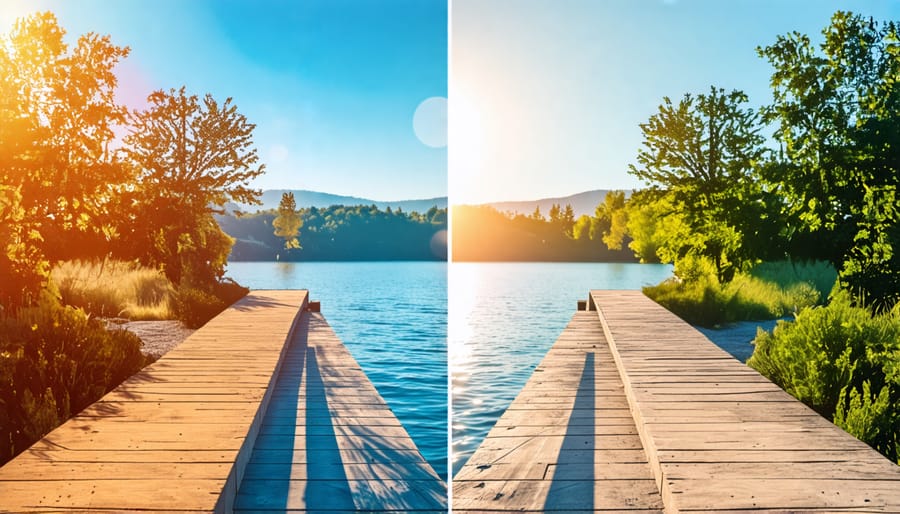
Refine your photography by mastering post processing. Begin by adjusting exposure to correct lighting mismatches and bring clarity to your images. Use color correction to balance hues and enhance vibrancy, making your photographs visually striking. Employ cropping techniques to eliminate distractions and tighten compositions, highlighting the subject’s impact. Explore tools like Adobe Lightroom and Photoshop to leverage advanced features such as layer adjustments and filters for professional-level enhancements.
Experiment with black and white conversions to create mood and emphasize contrasts, adding a timeless aesthetic to your portfolio. Incorporate sharpening techniques to highlight details and ensure your images have a crisp finish that stands out. By integrating these post-processing strategies, photographers can transform raw captures into compelling visuals that resonate with viewers and effectively tell their intended story.
Understanding Post Processing

Defining Post Processing
In photography, post processing is the art and science of enhancing images after they’ve been captured. It’s an essential part of a photographer’s toolkit, allowing for adjustments that can highlight a subject’s natural beauty, correct exposure, and bring out colors that might have been muted in the original capture. At its core, post processing involves using software like Adobe Photoshop or Lightroom to edit digital images, applying an array of techniques to transition them from good to stunning. This can include simple tasks like cropping and adjusting brightness, as well as more complex processes such as color grading, retouching, and compositing.
Post processing holds significant importance because it provides photographers with the flexibility to express their creative vision beyond the constraints of a camera. For instance, a landscape shot taken during a cloudy day can be transformed to emphasize the mood of the scene with the right tweaks to contrast and saturation. Understanding and mastering post processing is akin to developing your unique signature as a photographer, enabling you to craft images that resonate on a deeper visual and emotional level. This transformative step not only refines the technical aspects of an image but also enriches its storytelling potential.
Why Post Processing Matters
In the world of photography, post processing is more than just the icing on the cake—it’s an integral part of crafting compelling images. At its core, post processing involves refining and enhancing photographs to bring out their full potential, akin to how a sculptor polishes a statue to reveal its best features. For both enthusiasts and professional photographers, this step is crucial as it allows the photographer to realize their creative vision fully. Through adjustments in color, contrast, and sharpness, photographers can emphasize the elements that play a vital role in storytelling, much like using the right photography lighting equipment can transform an ordinary scene into something extraordinary. Whether correcting mistakes or making artistic choices, post processing ensures that the final image aligns with the photographer’s intent. Without it, photos may fall short of their potential, leaving the story incomplete. In a way, it’s the secret sauce that elevates a snapshot into a masterpiece, turning good photos into great ones and imbuing them with lasting impact.
Common Post Processing Techniques
Color Correction
In photography, color correction is a powerful tool that can significantly enhance the overall quality of an image. By adjusting the colors, you can transform a flat or unappealing photo into something vibrant and visually pleasing. Have you ever taken a picture that looked dull because of poor lighting or time of day? This is where color correction shines. By tweaking aspects like white balance and saturation, you can restore the natural balance of colors that our eyes perceive in the real world.
For instance, if you’ve captured a stunning landscape at sunset but find the colors too muted, adjusting the warmth and saturation can bring those brilliant hues of gold and red to life. This technique also helps in maintaining tonal consistency across a series of images, which is crucial for projects like wedding albums or branding shoots. Remember, while it’s tempting to push colors to surreal extremes, a subtle and mindful approach ensures that your images retain a natural yet enhanced charm.
Cropping and Resizing
Cropping and resizing are fundamental post-processing techniques that can dramatically alter the composition and overall impact of a photograph. As photographers, we often strive to capture the perfect shot, but sometimes the ideal composition isn’t achieved in-camera. This is where cropping comes to the rescue, allowing you to eliminate distracting elements or adjust the framing to highlight the primary subject better. Consider a landscape photo where the horizon feels slightly off or is too cluttered; a simple crop can transform the image into something more balanced and engaging.
Resizing, on the other hand, adjusts the dimensions of an image to suit various needs without changing its composition. It’s practical for maintaining the integrity of an image when displaying it on different platforms, from large-scale prints to digital screens. Knowing when and how to use these techniques effectively can be the difference between a good photo and a great one. Always keep in mind the final output—resizing and cropping can help ensure your photos resonate with viewers, whether in an exhibition or on social media.
Retouching
Retouching is an essential step in the post-processing phase, often used to fine-tune images by removing blemishes or unwanted elements, ensuring a polished final look. Imagine capturing a stunning portrait with perfect lighting, but a small blemish is distracting on the subject’s face. This is where retouching comes into play, utilizing tools like the healing brush or clone stamp in photo editing software to seamlessly correct imperfections. For landscape photography, retouching can involve removing distracting objects such as a stray piece of litter or an unexpectedly photobombing tourist in the background.
By carefully applying these techniques, photographers can maintain the image’s authenticity while enhancing its aesthetic appeal. Professionals often focus on subtlety, aiming for changes that go unnoticed to the untrained eye yet significantly improve the image. For budding photographers, practicing these techniques can elevate their work, making it more impactful and commercially viable. Real-world scenarios highlight the necessity of retouching: consider fashion photographers who subtly smooth textures without losing the natural look of skin, ensuring each photo tells its story effectively.
Tools and Software for Post Processing
Adobe Lightroom and Photoshop
Adobe Lightroom and Photoshop are indispensable tools for enhancing photography skills, offering an extensive suite of features for photographers at all levels. Lightroom excels in organizing and editing large batches of photos, streamlining the workflow with its powerful cataloging system. It allows users to adjust exposure, color balance, and composition easily, making it ideal for initial post processing. With its non-destructive editing capabilities, Lightroom ensures original images are always preserved, giving photographers peace of mind as they experiment with new techniques.
Photoshop shines in its ability to perform intricate edits, providing tools for advanced retouching and creative transformations. Its layers and masks features allow for precision and creativity, enabling edits that range from subtle enhancements to dramatic artistic effects. For instance, a landscape photographer can use Photoshop to blend multiple exposures seamlessly, creating stunning composites that capture a scene beyond what a single shot could achieve.
Together, these tools empower photographers to realize their creative vision, transforming ordinary shots into extraordinary visual narratives that captivate and engage audiences.

Alternative Tools
For photographers venturing into the world of post processing, there are a myriad of software options beyond the well-known Adobe Photoshop and Lightroom. Capture One is an excellent choice for those who prioritize color correction and tethered shooting in studio settings. Its advanced color grading capabilities allow for precise adjustments that can bring out the best in portrait and landscape photography.
Affinity Photo is another contender, offering a budget-friendly alternative with powerful features often found in higher-end programs. It’s particularly suitable for those who need comprehensive tools for retouching and digital painting but don’t want to commit to subscription models.
For enthusiasts turned professionals, ON1 Photo RAW and Luminar Neo are noteworthy for their user-friendly interfaces and AI-driven enhancements. These tools help streamline the editing process while achieving professional results, perfect for those looking to save time without sacrificing creativity.
Lastly, consider open-source options like GIMP, which provides a robust set of tools for those willing to delve deeper into customization. Whatever your preference, these alternative tools provide diverse avenues to elevate your photographic artistry.
Real-World Examples
Imagine a foggy morning in the Scottish Highlands where a photographer captures the moody landscape with a camera. Initially, the image might appear flat, but post-processing transforms it into a scene of breathtaking drama. By adjusting contrast and enhancing the mist, the once-muted colors now tell a captivating story.
Consider the world of fashion photography. A model standing against a plain backdrop becomes mesmerizing after subtle retouching. Skin tones are balanced, lighting is refined, and shadows are adjusted to highlight the model’s features while retaining a natural look. This attention to detail elevates the photograph from simple to stunning.
In the realm of travel photography, post-processing is equally transformative. For instance, imagine a bustling market street captured during a photographer’s adventure. Initially chaotic, the image undergoes careful cropping, saturation enhancements, and application of lens corrections, unveiling a vibrant and inviting scene that invites viewers into the heart of a culture. Such techniques are indispensable for perfecting stunning travel photography.
Through these real-world examples, it’s clear that post-processing not only rectifies technical imperfections but also enhances the emotional impact of photographs, turning moments into memories that resonate with viewers.
Practical Tips for Effective Post Processing
Post processing offers photographers extensive creative control, allowing one to elevate a good photo into a stunning one. Start by maintaining a clean workspace; efficiently organizing your digital library can save time and sanity. Embrace non-destructive editing techniques, like working with RAW files and using layers in editing software, to keep your original image intact while experimenting with adjustments. For example, when working on portrait photography, subtle enhancements such as refining skin tones or adjusting the lighting can create a dramatic impact.
Developing a personal style is also crucial. While presets and filters provide a quick fix, customizing your adjustments helps maintain authenticity. Regularly review your edited images to refine your techniques; understanding what works and what doesn’t will improve future projects. Finally, stay inspired and continuously learn by exploring online tutorials and photography communities where photographers share their insights. Balancing creativity with technical precision will maximize your post processing potential, ensuring every photo tells its story beautifully.
Conclusion
In conclusion, embracing post-processing is an integral part of modern photography that bridges the gap between a good photo and a great one. We’ve explored how this technique enhances not only the aesthetics of an image but also the photographer’s creative expression. From adjusting lighting and colors to implementing advanced techniques like HDR or layer blending, post-processing offers endless possibilities. As we’ve highlighted through real-world examples, experimenting with various tools and methods can significantly enhance your work. Whether you’re a budding hobbyist or seasoned professional, dive into post-processing with curiosity and imagination to truly elevate your photography.
























